2019-2020年沪教版牛津小学英语五年级上
- 格式:doc
- 大小:17.00 KB
- 文档页数:3
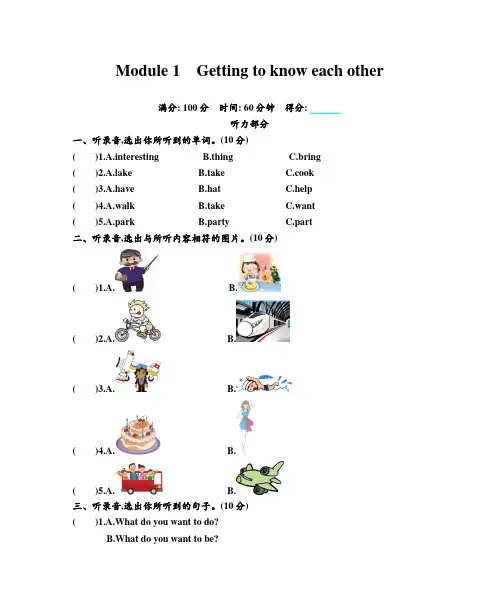
Module 1Getting to know each other满分: 100分时间: 60分钟得分:听力部分一、听录音,选出你所听到的单词。
(10分)()1.A.interesting B.thing C.bring()ke B.take C.cook()3.A.have B.hat C.help()4.A.walk B.take C.want()5.A.park B.party C.part二、听录音,选出与所听内容相符的图片。
(10分)()1.A. B.()2.A. B.()3.A. B.()4.A. B.()5.A. B.三、听录音,选出你所听到的句子。
(10分)()1.A.What do you want to do?B.What do you want to be?()2.A.I want to be a cook.B.I want to be a teacher.()3.A.It’s raining now.I have to go to school by bus.B.It’s raining now.I have to go to school by car.()4.A.My birthday is on 1st September.B.My birthday is on 1st October.()5.A.What’s your favourite fruit?B.What’s your favourite food?四、听录音,选出合适的答语。
(10分)()1.A.I come to school on foot. B.This is my bike.()2.A.Orange. B.English.()3.A.Sure. B.Yes, I do.()4.A.It’s my hat. B.I have an orange T-shirt. ()5.A.I’m a singer. B.I want to be a singer.笔试部分五、根据图片及首字母提示补全单词,完成句子。
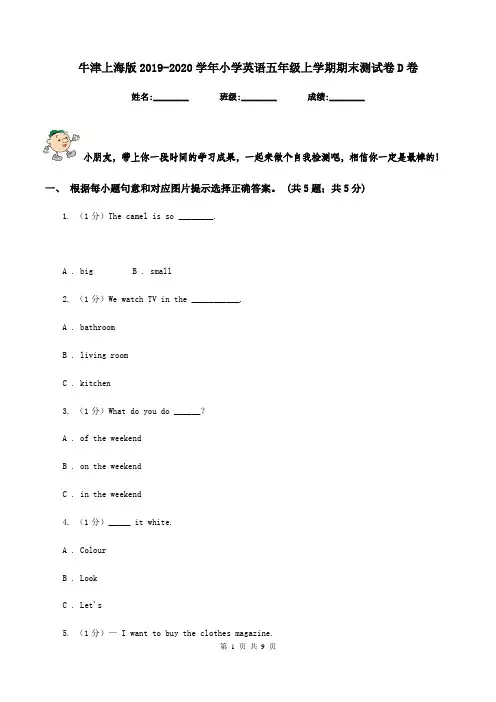
牛津上海版2019-2020学年小学英语五年级上学期期末测试卷D卷姓名:________ 班级:________ 成绩:________小朋友,带上你一段时间的学习成果,一起来做个自我检测吧,相信你一定是最棒的!一、根据每小题句意和对应图片提示选择正确答案。
(共5题;共5分)1. (1分)The camel is so ________.A . bigB . small2. (1分)We watch TV in the ___________.A . bathroomB . living roomC . kitchen3. (1分)What do you do ______?A . of the weekendB . on the weekendC . in the weekend4. (1分)_____ it white.A . ColourB . LookC . Let's5. (1分)— I want to buy the clothes magazine.—Let's go to the ______________.A . cinemaB . libraryC . bookstore二、判断题,判断对话内容是否与对应图片相符 (共5题;共5分)6. (1分)a pair of shorts7. (1分)— Can you see any pears?—Yes, I can.8. (1分)She has got a stomach ache.9. (1分)watch TV10. (1分)I want to go to the library.三、根据句意选择正确图片 (共1题;共5分)11. (5分)匹配⑴swimming________ A.⑵skipping________ B.⑶morning exercise________ C.⑷riding bikes________ D.⑸table tennis________ E.四、阅读题 (共1题;共5分)12. (5分)阅读理解My name is Ann. I'm an American girl. I'm a student in Class Three, Grade Five.Helen and I are on duty today. We go to the classroom and open the windows at seven in the morning. We clean the classroom at seven fifteen. The class begins at eight. After school, we play games on the play-ground. I go home at five.In the evening, my father, my mother and I watch TV at eight. I go to bed at nine ten.(1)Ann is from .A . the UKB . ChinaC . the USA(2)Ann is in .A . Class FourB . Grade FiveC . Class Two(3)We go to the classroom at .A . sevenB . seven twentyC . seven fifteen(4)The class begins at .A . 7: 00B . 7: 15C . 8: 00(5)We at eight in the evening.A . have dinnerB . watch TVC . go to bed五、填空题 (共1题;共1分)13. (1分)选词填空(1)Look! I________a new plane.(2)—________your name?—My name is Janet.(3)________the bag on the desk.(4)Your hands are too dirty. Please________them now.(5)—Who's that________?—She's my mother.(6)—Who's that________?—He's my father.(7)________me your toy car, please.(8)________is my new kite. It's nice.(9)—Where is my eraser?—It's ________your book(10)________touch your mouth.六、仿写题 (共1题;共1分)14. (1分)参考下列图片和单词,写几句话gently , happily, beautifully, loudly, quickly, slowly , quietly, softlyIt is Sunday today. The weather is nice. There are many children in the park. The wind is blowing gently. ……参考答案一、根据每小题句意和对应图片提示选择正确答案。
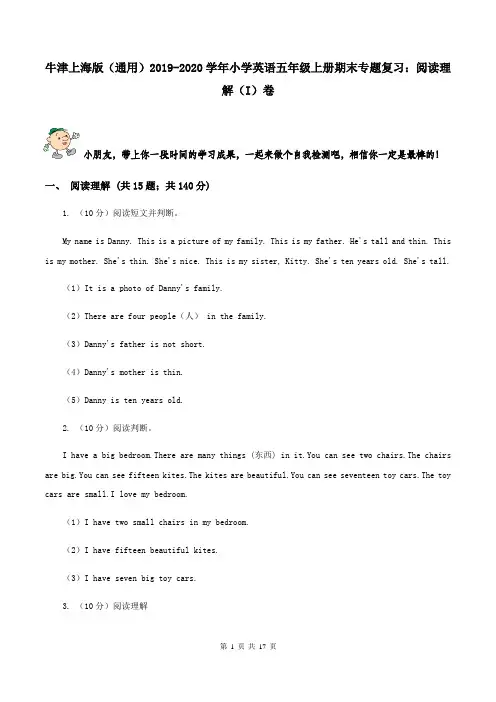
牛津上海版(通用)2019-2020学年小学英语五年级上册期末专题复习:阅读理解(I)卷小朋友,带上你一段时间的学习成果,一起来做个自我检测吧,相信你一定是最棒的!一、阅读理解 (共15题;共140分)1. (10分)阅读短文并判断。
My name is Danny. This is a picture of my family. This is my father. He's tall and thin. This is my mother. She's thin. She's nice. This is my sister, Kitty. She's ten years old. She's tall.(1)It is a photo of Danny's family.(2)There are four people(人) in the family.(3)Danny's father is not short.(4)Danny's mother is thin.(5)Danny is ten years old.2. (10分)阅读判断。
I have a big bedroom.There are many things (东西) in it.You can see two chairs.The chairs are big.You can see fifteen kites.The kites are beautiful.You can see seventeen toy cars.The toy cars are small.I love my bedroom.(1)I have two small chairs in my bedroom.(2)I have fifteen beautiful kites.(3)I have seven big toy cars.3. (10分)阅读理解Susan liked watching TV. When she watched TV, she liked eating snacks (零食).“You're getting fatter and fatter,Susan. Your face is round and fat. You're only 110 centimetres tall but you w eigh 30 kilograms. You're overweight,” said Susan's mother. “It doesn't matter,Mum. I like being fat,” said Susan.At school,some rude classmates called Susan “Fatty” when they saw her plump face and hands. Susan didn't like being called “Fatty”. She beg an doing exercise during the summer holidays. She skipped and lifted weights. She worked very hard. After the holidays,Susan weighed herself. “I'm 10 kilograms lighter. I'm thinner now. Nobody will call me “Fatty” again,” she thought happily.(1)The word “overweight” means “”.A . 偏痩B . 超重C . 标准(2)What did Susan's rude classmates call her?A . Fat girl.B . Fatty.C . Lovely pig.(3)What exercise did Susan do to keep fit?A . Skipped.B . Lifted weights.C . Both A and B.(4)How much did Susan weigh after the summer holidays?A . 40 kilograms.B . 30 kilograms.C . 10 kilograms.4. (10分)阅读短文,回答问题。
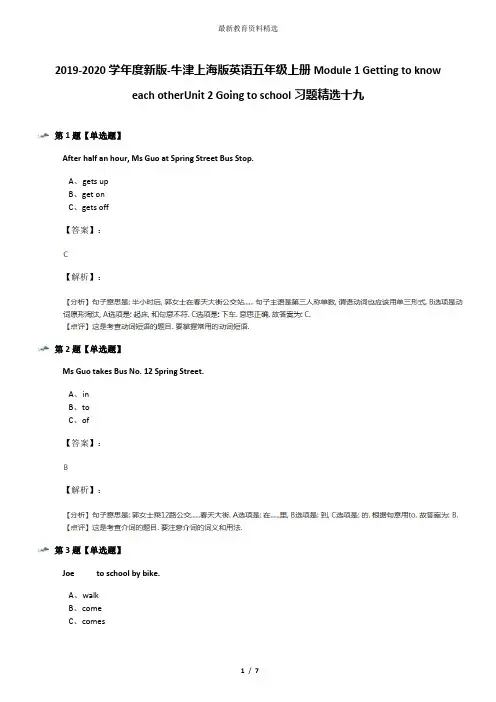
2019-2020学年度新版-牛津上海版英语五年级上册Module 1 Getting to know each otherUnit 2 Going to school习题精选十九第1题【单选题】After half an hour, Ms Guo at Spring Street Bus Stop.A、gets upB、get onC、gets off【答案】:【解析】:第2题【单选题】Ms Guo takes Bus No. 12 Spring Street.A、inB、toC、of【答案】:【解析】:第3题【单选题】Joe to school by bike.A、walkB、comeC、comes【答案】:【解析】:第4题【单选题】I want _____ English.A、teachB、teacherC、to teach【答案】:【解析】:第5题【判断题】I walk to school on foot.A、正确B、错误【答案】:【解析】:第6题【填空题】“地铁”用英语怎么说:______. 【答案】:【解析】:第7题【填空题】—______do you come to school?— By bike.【答案】:【解析】:第8题【阅读理解】下图是Ann全班同学上学方式的调查图,看图判断句子正误Fifteen students come to school on foot.A、正确B、错误Five students come to school by bus.A、正确B、错误Ten students come to school by bike.A、正确B、错误No one comes to school by car in Arm’s class.A、正确B、错误There are forty students in Ann’s class.A、正确B、错误【答案】:【解析】:第9题【句型转换】句型转换。
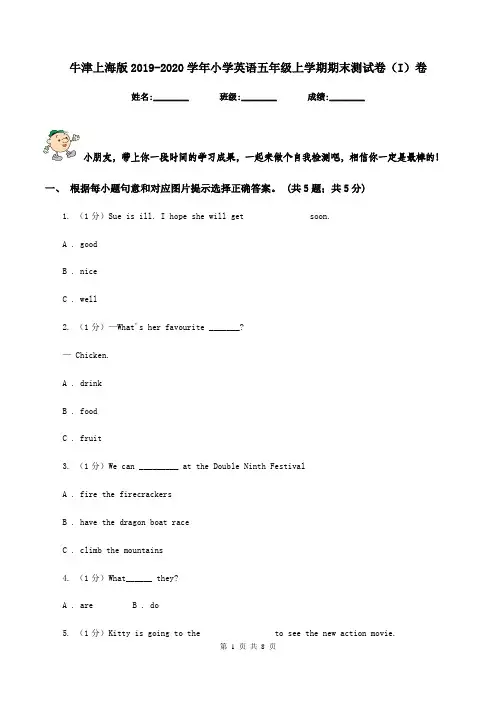
牛津上海版2019-2020学年小学英语五年级上学期期末测试卷(I)卷姓名:________ 班级:________ 成绩:________小朋友,带上你一段时间的学习成果,一起来做个自我检测吧,相信你一定是最棒的!一、根据每小题句意和对应图片提示选择正确答案。
(共5题;共5分)1. (1分)Sue is ill. I hope she will get soon.A . goodB . niceC . well2. (1分)—What's her favourite _______?— Chicken.A . drinkB . foodC . fruit3. (1分)We can _________ at the Double Ninth FestivalA . fire the firecrackersB . have the dragon boat raceC . climb the mountains4. (1分)What______ they?A . areB . do5. (1分)Kitty is going to the to see the new action movie.A . libraryB . hospitalC . cinema二、判断题,判断对话内容是否与对应图片相符 (共5题;共5分)6. (1分)—What do you have, Peter?—I have an egg.7. (1分)listening8. (1分)Mike's mother is a teacher.9. (1分)He's a driver.10. (1分)I've got a dog.三、根据句意选择正确图片 (共1题;共5分)11. (5分)读一读,将下列图片与相应的对话匹配⑴ ________ A. —What do you see? —I see a bird.⑵ ________ B. —What do you see?—I see a frog.⑶ ________ C.—What do you see?—I see a monkey.四、阅读题 (共1题;共5分)12. (5分)看图,选择正确的答案(1)The man in a ___________ and a pair of ___________ is a reporter.A . shirt; trousersB . T-shirt; shortsC . jacket; shoes(2)The woman in a blue uniform is a ______.A . policemanB . painterC . policewoman(3)The woman in a white __________ and a white __________ is a doctor.A . coat; capB . sweater; capC . dress; cap(4)The woman is a ___________. She is tall and strong.A . driverB . cookC . doctor(5)The woman in a ___________ and a ___________is a teacher.A . blouse; skirtB . shirt; dressC . sweater; skirt五、填空题 (共1题;共1分)13. (1分)读一读,选择合适的词把句子补充完整toys maths books quiet short hair long hair (1)My friend is near the window. He has________.(2)Look! I am a________girl. I like books.(3)My brother has three cute________.(4)I have two________in my schoolbag.(5)This girl has________.六、仿写题 (共1题;共1分)14. (1分)今天是周六,怀特先生一家呆在家里,他们都在干什么呢?请你根据图片内容描述一下。
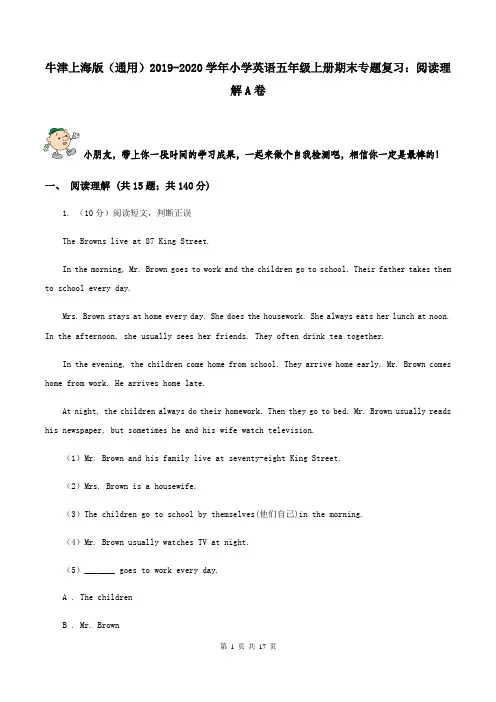
牛津上海版(通用)2019-2020学年小学英语五年级上册期末专题复习:阅读理解A卷小朋友,带上你一段时间的学习成果,一起来做个自我检测吧,相信你一定是最棒的!一、阅读理解 (共15题;共140分)1. (10分)阅读短文,判断正误The Browns live at 87 King Street.In the morning, Mr. Brown goes to work and the children go to school. Their father takes them to school every day.Mrs. Brown stays at home every day. She does the housework. She always eats her lunch at noon. In the afternoon, she usually sees her friends. They often drink tea together.In the evening, the children come home from school. They arrive home early. Mr. Brown comes home from work. He arrives home late.At night, the children always do their homework. Then they go to bed. Mr. Brown usually reads his newspaper, but sometimes he and his wife watch television.(1)Mr. Brown and his family live at seventy-eight King Street.(2)Mrs. Brown is a housewife.(3)The children go to school by themselves(他们自己)in the morning.(4)Mr. Brown usually watches TV at night.(5)_______ goes to work every day.A . The childrenB . Mr. BrownC . Mrs. Brown(6)The children come home from school _______ in the evening.A . earlyB . lateC . Sorry. I don't know.(7)Mrs. Brown _______ in the afternoon.A . sees her friendsB . drinks tea with friendC . Both A&B(8)The children always _______ first at night.A . watch televisionB . do their homeworkC . go to bed2. (10分)阅读理解。
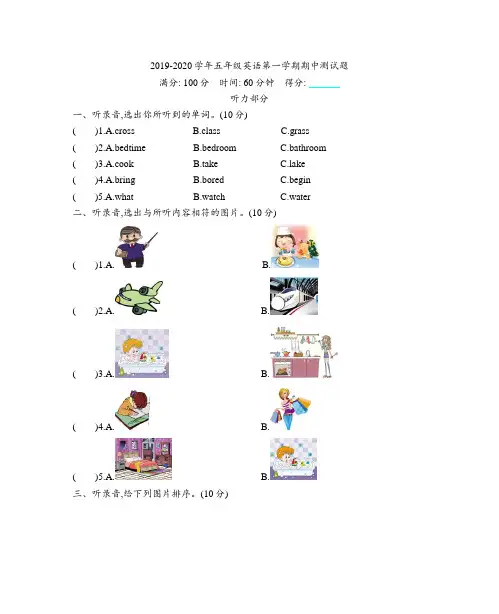
2019-2020学年五年级英语第一学期期中测试题满分: 100分时间: 60分钟得分:听力部分一、听录音,选出你所听到的单词。
(10分)()1.A.cross B.class C.grass()2.A.bedtime B.bedroom C.bathroom ()3.A.cook B.take ke()4.A.bring B.bored C.begin()5.A.what B.watch C.water二、听录音,选出与所听内容相符的图片。
(10分)()1.A. B.()2.A. B.()3.A. B.()4.A. B.()5.A. B.三、听录音,给下列图片排序。
(10分)() () ()() ()四、听录音,选出合适的答语。
(10分)()1.A.I’m making a model plane.B.I often go to the park on foot.()2.A.No, I mustn’t.B.Sure.()3.A.It’s on 2nd October.B.It’s sunny and warm.()4.A.I’m in my bedroom.B.I’m writing a letter.()5.A.I often go to the supermarket in the morning.B.I often go to the supermarket by bike.笔试部分五、根据图片及首字母提示补全单词,完成句子。
(10分)1.—What are you doing?—I’m w TV.2.—Do you often w to school?—Yes, I do.3.—Who is that p?—Jim.4.—Where’s your brother?—He is in the b.5.—What do you often do on weekend?—I often v my friends.六、单项选择。
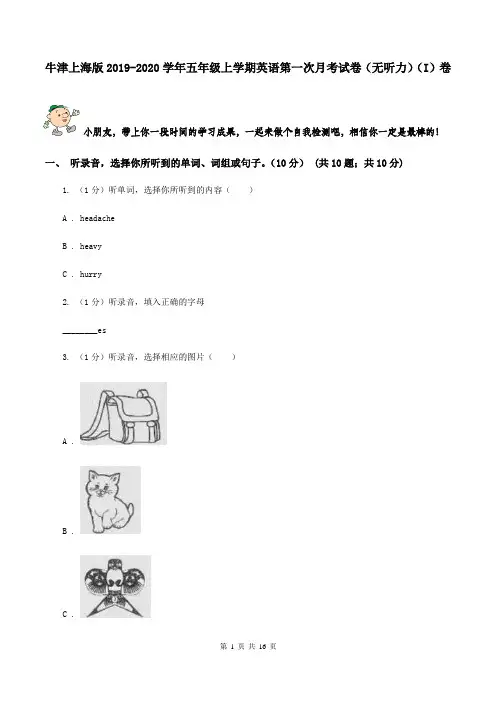
牛津上海版2019-2020学年五年级上学期英语第一次月考试卷(无听力)(I)卷小朋友,带上你一段时间的学习成果,一起来做个自我检测吧,相信你一定是最棒的!一、听录音,选择你所听到的单词、词组或句子。
(10分) (共10题;共10分)1. (1分)听单词,选择你所听到的内容()A . headacheB . heavyC . hurry2. (1分)听录音,填入正确的字母________es3. (1分)听录音,选择相应的图片()A .B .C .4. (1分)听ー听,选出你所听到的单词()A . tomatoB . potatoC . carrot5. (1分)听录音, 选择你所听到的单词()A . summerB . sweaterC . swim6. (1分)听录音,选出你所听到的单词()A . handB . taxiC . eye7. (1分)听录音,选择与你所听到的内容相符的图片()A .B .C .8. (1分)There are some ________ (flowers/books) in the ________ (bedroom /garden).9. (1分)10. (1分)二、听录音,选择正确答语。
(10分) (共5题;共10分)11. (2分)听音,选出你听到的句子()A . You must drink more water.B . You must take some medicine.12. (2分)This is my .A . faceB . head13. (2分)听录音.选出你听到的单词A . sweetB . treeC . three14. (2分)听录音。
根据所听的顺序,用阿拉伯数字在括号里标出序号。
________________________________________15. (2分)三、听录音,判断图片的正误。
(12分) (共8题;共12分)16. (1.5分)17. (1.5分)18. (1.5分)Australia is a very big country and I live in the north.19. (1.5分)听录音,选出恰当的应答语()A . There is a beautiful garden.B . There was only one small building.20. (1.5分)听录音,选择你所听到的句子()A . I have some apples.B . 1 like it very much.C . I have some water.21. (1.5分)Where does the woman work?A . In a factory.B . In a restaurant.C . In a shop.22. (1.5分)听音,匹配。
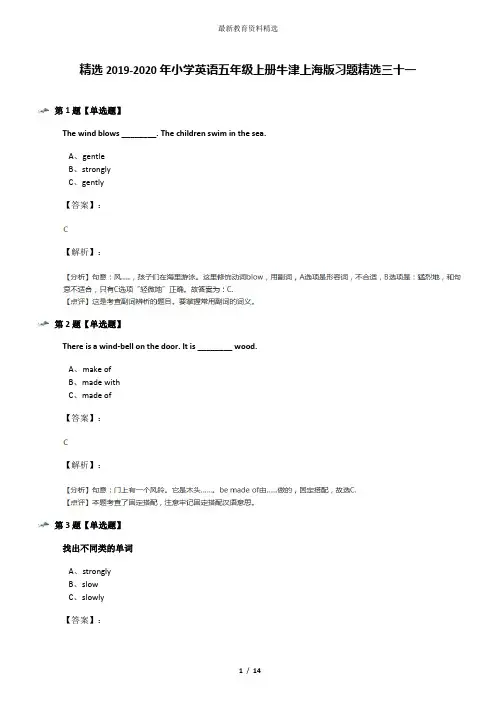
精选2019-2020年小学英语五年级上册牛津上海版习题精选三十一第1题【单选题】The wind blows ________. The children swim in the sea.A、gentleB、stronglyC、gently【答案】:【解析】:第2题【单选题】There is a wind-bell on the door. It is ________ wood.A、make ofB、made withC、made of【答案】:【解析】:第3题【单选题】找出不同类的单词A、stronglyB、slowC、slowly【答案】:【解析】:第4题【单选题】根据所给单词划线部分的发音,选择正确的音标:breadA、/i?/B、/e/C、/e?/【答案】:【解析】:第5题【单选题】I have a fever. I should have a lot of ________.A、juiceB、milkC、water【答案】:【解析】:第6题【单选题】Mr Li is going to talk about fire ________ in our school tomorrow.A、safetyB、safeC、dangerous【答案】:【解析】:第7题【单选题】根据所给单词划线部分的发音,选择正确的音标:stronglyA、/?/B、/?/C、/?/【答案】:【解析】:第8题【阅读理解】阅读短文,判断正误If you use fire carefully, fire can help you a lot. But if you don"t, you will be dangerous.People know the danger of fire. It"s good for us to know how to protect us from fire.First, get a smoke alarm in the house. It can make a loud sound. The sound tells everyone to leave the house immediately (立刻) in case of emergency (紧急情况).Next, have an escaping (逃生) plan. Make sure we all know where is the safety exit (出口) of your house. In case of fire emergency, everyone should follow the right way to escape.Then, it is necessary for every family to buy a fire extinguisher (灭火器). And also make sure that every family member know how to use it.Sometimes fire is dangerous. We must be careful. We know the danger of fire and we should know how to protect ourselves.We should get a smoke alarm. So we can find the fire and escape quickly.We should have an escaping plan. We should know where the safety exit. We should buy a fire extinguisher and learn to use it.Fire can help us a lot if we use it carelessly.A、正确B、错误The smoke alarm can tell us the fire danger.A、正确B、错误We should follow the right way to escape.A、正确B、错误A fire extinguisher can help us put out the fire.A、正确B、错误【答案】:【解析】:第9题【阅读理解】根据短文内容,回答问题Many years ago, people use a stick, a large piece of wood and dry leaves to make a fire. Today, wood, gas (煤气) and electricity (电) can all make a fire. I think wood is the most dangerous. And I like gas most because it"s easy.People use fire in many ways. At home, people use fire to cook food and boil water. In factories, workers use fire to melt (熔化) metals (金属) to makes things of different shapes. Some workers use fire to make glass.Fire can help us to do many things, but sometimes fire is dangerous. Cigarettes and campfires can all start a fire in the countryside, in schools and at homes. We must be careful. We mustn"t smoke in the countryside, and we mustn"t cook without an adult (成年人). We mustn"t play with matches. We mustn"t play around a fire.Can people use the dry leaves to make a fire?What do people do with fire at home?Do workers make glass with fire?Is fire dangerous?Can children cook without an adult?【答案】:【解析】:第10题【阅读理解】阅读短文,选择正确答案。
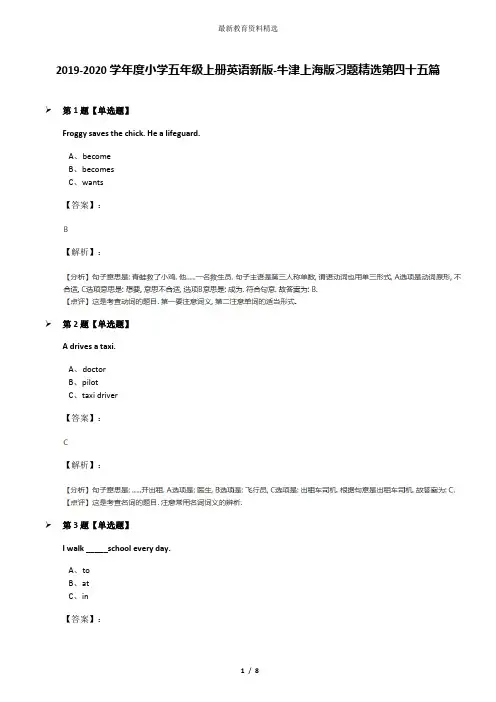
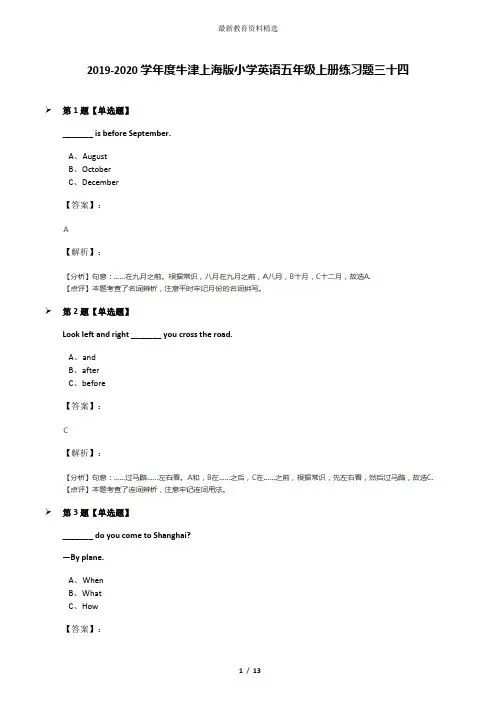
2019-2020学年度牛津上海版小学英语五年级上册练习题三十四➢第1题【单选题】_______ is before September.A、AugustB、OctoberC、December【答案】:【解析】:➢第2题【单选题】Look left and right _______ you cross the road.A、andB、afterC、before【答案】:【解析】:➢第3题【单选题】_______ do you come to Shanghai?—By plane.A、WhenB、WhatC、How【答案】:【解析】:➢第4题【单选题】—_______ do you leave home?—At half past seven.A、HowB、WhenC、Where【答案】:【解析】:➢第5题【单选题】All the students _______ happy _______ see each other.A、are, /B、is, toC、are, to【答案】:【解析】:➢第6题【单选题】There are _______ students. The _______ one is May.A、twenty, twentyB、twentieth, twentyC、twenty, twentieth【答案】:【解析】:➢第7题【单选题】—Is it January _______ February?—It"s February.A、orB、forC、and【答案】:【解析】:➢第8题【单选题】—_______ does the film begin?—At five p. m.A、WhatB、HowC、When【答案】:【解析】:➢第9题【单选题】These shoes are new but _______ not dear.A、theyB、it"sC、they"re【答案】:【解析】:➢第10题【单选题】读—读,根据所给音标,选出对应的单词:/s?k/A、sackB、sick【答案】:【解析】:➢第11题【阅读理解】阅读短文,判断正误John and Jack are going to the park. John has got a small bag. He has three packets of noodles, a cake and an apple. Jack has got a big bag. He"s got two large bottles of water, three oranges, four bananas, two hamburgers and a packet of crisps. Suddenly(突然) they see a spaceship in the sky. It is small and round. It is falling. A big red man comes out. The boys are afraid. The red man smiles(微笑)at them. He needs some water for his spaceship. The spaceship cannot fly without(没有)water. Jack gives a large bottle of water to him. He puts it in the spaceship. The spaceship flies away.John and Jack are going to the zoo.A、正确B、错误John"s bag is small.A、正确B、错误John and Jack can see a spaceship in the sky.A、正确B、错误The red man needs a bottle of juice.A、正确B、错误The spaceship is big and round.A、正确B、错误John gives a large bottle of water to the red man.A、正确B、错误【答案】:【解析】:。
沪教版牛津小学英语五年级上-- 模块四自然世界
模块四自然世界
[00:06.19]Unit 1 Wild animals
[00:08.62]单元一野兽动物
[00:11.05]Look and read
[00:12.51]看并且读
[00:13.98]Look at this animal.It is big.It is brown.It has long arms and long legs.
[00:19.25]看这个动物。
它是大的。
这是褐色的。
它有长臂和长的腿。
[00:24.53]It is a monkey.It lives in a zoo.The monkey is climbing. [00:28.30]它是一只猴子。
它生活在动物园。
这正在猴子是攀登。
[00:32.08]It can climb to the top of the cage,It can swing on the rope. [00:35.60]它能爬到笼的顶,它能在绳上摇摆。
[00:39.13]This is the zoo-keeper.He feeds the animals.
[00:42.10]这个是动物园看守员.他喂动物。
[00:45.06]He likes the baby monkeys.Some monkeys live in the jungle. [00:48.48]他喜欢小猴子。
一些猴子喜欢在丛林里。
[00:51.91]They like fruit and leaves.
[00:53.63]他们喜欢水果和树叶。
[00:55.35]page 45
[00:56.93]第四十五页
[00:58.51]Look and say
[01:00.04]看并且说
[01:01.57]In the jungle
[01:03.86]在丛林
[01:06.14]I can't swim I can dive.I can swim I can see a crocodile [01:12.66]我不能游泳我能潜水.我能游泳我看见鳄鱼。
[01:19.18]I can swim.I like monkeys.I eat monkeys.
[01:24.24]我能游泳。
我喜欢猴子。
我吃猴子。
[01:29.31]We don't like crocodiles.We can climb trees.
[01:34.43]我们不喜欢鳄鱼。
我们能攀登树。
[01:39.55]Read a poem
[01:41.17]读一首诗
[01:42.79]Eating bananas
[01:44.62]正在吃香蕉
[01:46.45]'Bananas,'says the money,'Are what I like to eat.
[01:49.73]‘香蕉’猴子说,'是我喜欢吃的。
[01:53.01]And if my hands are busy I can peel them with my feet.' [01:56.34]如果我的手是忙的我能用我的脚剥他们,
[01:59.67]Now listen!
[02:54.80]现在听!
[03:49.93]page 46
[03:51.51]第四十六页
[03:53.09]Read a poem
[03:54.57]读一首诗
[03:56.04]Tiger
[03:57.32]老虎
[03:58.60]His face is sad.He eats his meat and looks at me.Through the bars of his cage.
[04:06.09]他的脸悲伤的.他吃他肉并且看我.穿过他笼的马上齿龈。
[04:13.57]page 47
[04:15.19]第四十七页
[04:16.81]Unit 2 Butterflies
[04:18.80]单元二蝴蝶
[04:20.78]Look and say
[04:22.56]看并且说
[04:24.33]In the park
[04:25.95]在公园
[04:27.57]What's that?It's a butterfly.It's beautiful!
[04:32.14]那个是什么?它是一只蝴蝶。
它是漂亮的!
[04:36.72]What's this?I don't know.It's ugly.Let's look at a book. [04:41.20]这个是什么?我不知道。
它是丑陋的。
让我们看这书。
[04:45.68]At school
[04:47.35]在学校
[04:49.02]Miss Fang,What's this?I don't know.Kitty.
[04:52.55]芳小姐,这个是什么?我不知道。
基蒂。
[04:56.07]Let's look at this book.It's a cocoon.How do you spell that in English?
[05:01.36]让我们看这书。
它是茧。
用英语怎么拼写?
[05:06.65]C-O-C-O-O-N
[05:12.72]C-O-C-O-O-N
[05:18.80]What's a cocoon?Let's read the book,Kitty?
[05:22.43]茧是什么?让我们读这书,基蒂?
[05:26.06]page 48
[05:27.59]第四十八页
[05:29.12]Look and read
[05:30.55]看并且读
[05:31.99]A butterfly is an insect.It lays eggs on a leaf.The eggs are small and white.
[05:38.81]一只蝴蝶一只昆虫.它蛋放在一个叶子上.这蛋是小的并且白的。
[05:45.63]The eggs bee small caterpillars.The small caterpillars eat leaves.
[05:51.15]这蛋变成小的毛虫。
这小毛虫吃树叶。
[05:56.68]The caterpillars grow.This caterpillar is big and fat. [06:01.25]这毛虫渐渐成长.这个毛虫是大的和肥的。
[06:05.82]It makes a little house.It is a cocoon.The cocoon is brown.
[06:11.50]它做小的房子.它是一只茧.这茧是棕色的。
[06:17.18]The cocoon opens.A butterfly es out.it is wet.
[06:22.11]这茧打开。
这蝴蝶出来。
它是湿的。
[06:27.03]The sun makes the butterfly dry.It is a beautiful butterfly. [06:31.60]这太阳把晒蝴蝶干了.它是一只美丽的蝴蝶。
[06:36.17]page 49
[06:37.64]第四十九页
[06:39.10]Make a butterfly
[06:40.57]做个蝴蝶
[06:42.05]1 Draw a body,a head and two feelers.
[06:47.18]1 画一个身体,一个头和两个触须。
[06:52.32]2 Draw two big wings.
[06:55.70]2 画两个大翅膀。
[06:59.08]3 Draw two small wings
[07:02.52]3 画两个小翅膀。
[07:05.95]4 Colour your e two colours.
[07:10.08]4 涂上颜色你的蝴蝶。
使两种颜色。
[07:14.21]5 Cut out the butterfly.
[07:17.08]5 把蝴蝶剪出来。
[07:19.95]I like butterflies.Which one do you like,Alice?
[07:24.03]我喜欢蝴蝶。
你喜欢哪个?艾丽丝?
[07:28.10]I like the red and yellow one.Which one do you like,Danny? [07:32.13]我喜欢红色和黄色的那个。
你喜欢哪个?丹尼?
[07:36.15]I like the green and blue one but I don't like the black and purple one.
[07:40.83]我喜欢绿色和蓝色的那个。
但我不喜欢黑色的和紫色的。